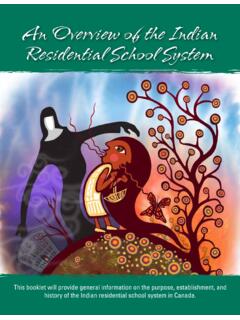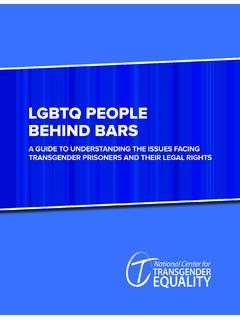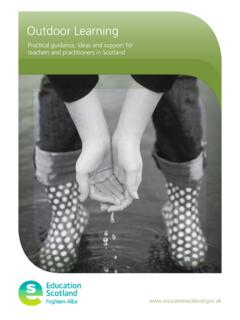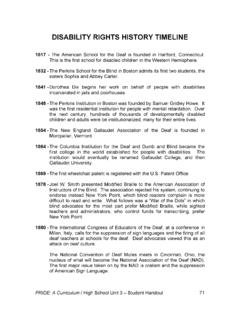Transcription of An Overview of the Indian Residential School System
1 An Overview of the Indian Residential School SystemThis booklet will provide general information on the purpose, establishment, and history of the Indian Residential School System in Overview of the Indian Residential School SystemThis booklet will provide general information on the purpose, establishment, and history of the Indian Residential School System in Union of Ontario indians gratefully acknowledges the financial contribution from the Truth and Reconciliation Commission of Canada for this : If this booklet causes any crisis or distress, call the Indian Residential Schools Crisis Line at by Donald Chr by the Union of Ontario indians based on research compiled by Karen by Creative of Ontario indians .
2 All Rights reproduction of any of this material without written permission of the Union of Ontario indians is strictly Printing1An Overview of the Indian Residential School SystemThis booklet will provide general information on the purpose, establishment, and history of the Indian Residential School System in of the Indian Residential School System The goal of Indian Residential schools was to assimilate indians into society. The Canadian government operated Indian Residential schools in partnership with the Anglican, Catholic, Methodist, and Presbyterian churches, among others. The Canadian government was financially responsible for Indian Residential schools.
3 Indian Residential schools operated in all Canadian provinces and territories except Prince Edward Island, New Brunswick, and Newfoundland. Indian Residential schools operated in Canada between the 1870s and the 1990s. The last Indian Residential School closed in 1996. Children between the ages of 4-16 attended Indian Residential School . It is estimated that over 150,000 Indian , Inuit, and M tis children attended Indian Residential Purpose and Establishment of the Indian Residential School SystemWhat Was An Indian Residential School ?Before Residential schools existed, industrial schools existed both on and off-reserve.
4 They were a form of manual labour School . Eventually, the industrial School model was phased out, in favour of the Residential School Indian Residential School System was mainly located off-reserve, attended by children for the duration of a 10-month academic year. In some cases, children lived at the Residential School year round. The students time was divided between academic learning, religious prayer, and tasks. Why Were The Schools Created?The Indian Residential School System was based on the clearly stated goals of assimilating indians , deemed to be the most effective way to civilize the indians ..[I]f anything is to be done with the Indian , we must catch him very young.
5 The children must be kept constantly within the circle of civilized conditions. Nicholas Flood Davin, Report on Industrial Schools for indians and Half-Breeds, Campbell Scott, who was the Deputy Minister of Indian Affairs in Canada in 1920, has been quoted on the record saying, I want to get rid of the Indian problem. I do not think as a matter of fact, that the country ought to continuously protect a class of people who are able to stand Our objective is to continue until there is not a single Indian in Canada that has not been absorbed into the body politic and there is no Indian question, and no Indian Department. How Were The Schools Created?
6 In 1884, amendments to the Indian Act, 1876 were adopted and provided for the creation of Indian Residential schools. The Indian Residential schools in Canada were predominately funded and operated by the Government of Canada and Roman Catholic, Anglican, Methodist, Presbyterian and United churches. To a lesser scale, some Indian Residential schools were funded by provincial governments or by the various religious 1920, amendments to the Indian Act make it mandatory for every Indian child between the ages of seven and six-teen years, to attend Indian Residential School . In 1933, legal guardianship of the Indian children attending Indian Residential School was assumed by the principals of those Indian Residential schools, upon the forcible surrender of legal custody by Many Children Attended The Schools?
7 It is estimated that over 150,000 First Nations, Inuit and M tis children, between the ages of 4 and 16 years old, attended Indian Residential schools in Canada. How Many Schools Were There?There are 139 Indian Residential schools identified within the Indian Residential School (IRS) Settlement Agreement. This figure represents the Residential schools that were funded and operated in whole by the federal government or in part by the federal government and a religious is to be noted that there were a number of other schools that were funded by the provincial government and/or a religious order. These schools are not included in the IRS Schools Existed in Ontario?
8 Bishop Horden Hall (Moose Fort, Moose Factory) located in Moose Factory Island, operated by the Anglican Church. Cecilia Jeffrey (Kenora, Shoal Lake) located in Kenora, operated by the Presbyterian Church. Chapleau (St. Joseph s, St. John s) located in Chapleau, operated by the Anglican Church. Cristal Lake High School located in Cristal Lake, operated by the Mennonite Church. Fort Frances (St. Margaret s) located in Fort Frances, operated by the Catholic Church. Fort William (St. Joseph s) located in Fort William, operated by the Catholic Church. McIntosh (Kenora) located in McIntosh, operated by the Catholic Church. Mohawk Institute located in Brantford, operated by the Anglican Church.
9 Mount Elgin (Muncey, St. Thomas) located in Muncey, operated by the United Church. Pelican Lake (Pelican Falls) located in Sioux Lookout, operated by the Anglican Church. Popular Hill located in Popular Hill, operated by the Mennonite St. Anne s (Fort Albany) located in Fort Albany, operated by the Catholic Church. St. Mary s (Kenora, St. Anthony s) located in Kenora, operated by the Catholic Church. Shingwauk located in Sault Ste. Marie, operated by the Anglican Church. Spanish Boys School (Charles Garnier, St. Joseph s, Wikwemikong Industrial) located in Spanish, operated by the Catholic Church. Spanish Girls School (St. Joseph s, St.)
10 Peter s, St. Anne s, Wikwemikong Industrial) located in Spanish, op-erated by the Catholic Church. Stirland Lake High School located in Stirland Lake, operated by the Mennonite Happened At The Schools?For the most part, children do not recall positive experiences while attending Indian Residential School . They were forced to abandon their language, cultural beliefs, and way of life, and mandated to adopt the European languages of English or French, foreign religious denominations, and new habits. The following is a list of some of the forced changes and unpleasant traumatic experiences lived by former students that have been documented: Forbidden to speak their Aboriginal languages Required to speak English or French Required to adopt religious denomination of the School Forced style of prayer consistent with School denomination Forced haircut, or shaved head Use of toxic chemical to clean children s hair and skin Forced to wear uniform as designed by the School Forced to shower, no access to bath tubs Lack of nutritious diet Insufficient quantities of food Served spoiled food Segregation based on gender.





